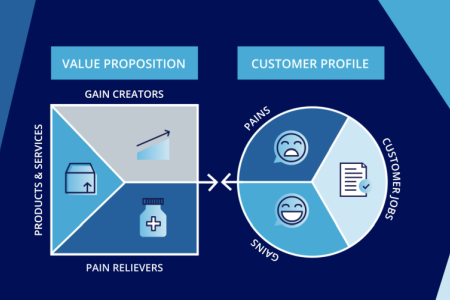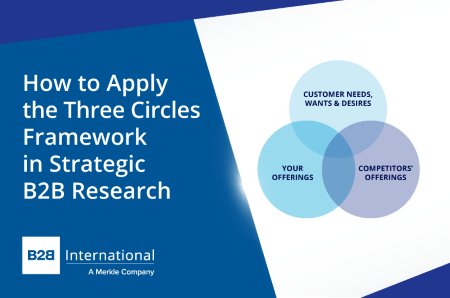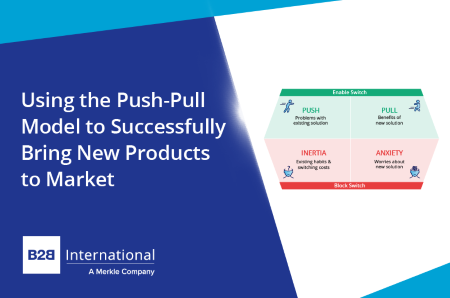The B2B Insights Podcast Channel was created to help marketing and insights professionals navigate the rapidly-changing world of B2B markets and develop the strategies that will propel their brand to the top.
Subscribe today for your dose of exclusive insights from the B2B market experts.
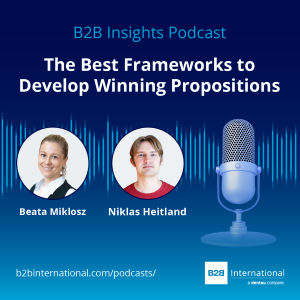
In this episode of the B2B Insights Podcast, B2B International’s Beata Miklosz and Niklas Heitland share their favorite strategic frameworks to develop winning value propositions.
Key discussion points:
- The importance of creating value in business
- The role of frameworks in market research
- The Value Proposition Canvas
- The Three Circles Framework
- The Kano Model
- The Push-Pull Framework
Listen to the full episode:
Listen on Spotify >
Listen on Apple Podcasts >
Watch the full video:
Read the full transcript:
Jump to section:
- Importance of Creating Value in Business
- The Role of Frameworks in Research and Analysis
- The Value Proposition Canvas
- Competitor Analysis with the Three Circles Framework
- Understanding Customer Needs with the Kano Model
- Push-Pull Framework for Introducing New Propositions
Importance of Creating Value in Business
Beata: Hello and welcome to the B2B Insights podcast. My name is Beata Miklosz. I’m a Research Director at B2B International in Germany, and I will be the host for today’s episode. I’m joined by my colleague Niklas Heitland, who is a Senior Research Executive in Düsseldorf. How are you, Niklas?
Niklas: I’m very good. I hope the weather is better for you in Munich today, but thanks for inviting me. I’m really looking forward to today’s discussion.
Beata: Thank you very much. Yes, the weather is really nice today, and thank you for accepting the invite. I’m super excited about today’s topic because we will be discussing our favorite frameworks for creating winning value propositions. I think the topic of value should really be at the heart of every business, whether it is about the value for our customers or about creating value for society, our employees, or potential employees. This should be the ultimate goal for every company.
Very often we speak about growth and looking for new growth opportunities, which is super important. However, if we do not create true value for customers and other stakeholders, the business will not grow. If we really focus on creating value, growth will follow naturally. As mentioned, today we will be talking about our favorite frameworks. You’ve been with the business now for almost three years. What do you think about using frameworks in research? What role do they play?
The Role of Frameworks in Research and Analysis
Niklas: Yeah, I imagine frameworks like a dessert in a restaurant. You’ve gone through the main course, which is our whole analysis packed with numbers, data, and insights. The goal is to finish with a bang, like a memorable dessert. When it is a good ending, you remember it even more and in a good light. That’s where frameworks come in for good research. They take all this prior analysis, which can sometimes be overwhelming, especially for other departments not deeply involved in market research, and wrap it up in a way that’s easy to digest. Ideally, you should be able to glance at the framework and immediately see what the results are saying about your research and what the key themes are.
A solid framework should be accessible to everyone, even those not deeply involved in market research. You can share it across the whole company, and everyone will understand the main points. That’s why I think frameworks are a really important part of good research. It’s a good way to end the report and summarize everything again.
Beata: Yeah, I couldn’t agree more. I like that you mentioned frameworks are not only used by market research or marketing specialists. They can be used by anyone in the company. Frameworks are great for summarizing data and showing the most important findings in an understandable way. They are also great for gathering ideas and organizing insights we already have for brainstorming within the organization.
Frameworks can be used both at the end of the process, as you mentioned, and at the beginning when you want to organize thoughts and identify what information is still needed to make solid decisions. Essentially, frameworks can be used throughout the market research and strategic processes by anyone in the organization, regardless of their role.
Now, let’s dive straight into our favorite frameworks.
The Value Proposition Canvas
Beata: So, what is your favorite framework for creating winning value propositions?
Niklas: Yeah, thanks for asking. My favorite framework is the Value Proposition Canvas. Think of it as the heart of your business model. It’s all about the promise you make to your customers—the unique value or benefit they get from your services. For example, in our market research, it’s not just about what you sell in the end, but why it actually matters to them. Creating a strong value proposition is key for your marketing, pricing, and overall success.
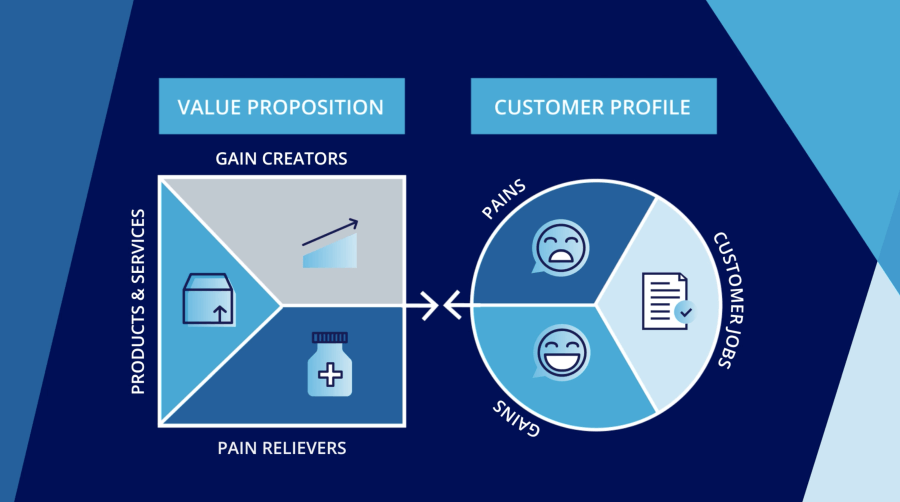
The Value Proposition Canvas is a great tool that can help you nail this down. It’s split into two parts: on one side, you look at your customers and what they need; on the other side, you focus on how your services, like our market research, meet those needs. When these two sides match up, we achieve what’s called a problem-solution fit.
Ideally, that’s the spot where we want to be with our services. Going into more detail, on the right side, we have the customer segment. You want to create a separate canvas or model for each customer group or persona. This helps you understand which part of your offering will resonate with each audience, as different audiences have different needs.
On the right side, you have the customer jobs—these are the tasks your customer needs to accomplish. This isn’t about your product yet; it’s about addressing the needs and goals of the chosen customer segment. When we talk about the jobs customers have, we’re listening to everything that matters to them, including functional, social, and emotional aspects.
You ask yourself: What tasks and jobs does the customer need to accomplish? What strategies do they use to solve these tasks? When and in what context do they need to complete these tasks? For example, a startup company might want to understand the market potential for their new app or product. Their jobs could include identifying target demographics (a functional job), validating their business concepts (an emotional job), and presenting data-driven insights to potential investors (a social job).
Of course, they will face some pains—things that cause frustration while trying to complete these tasks. For example, a startup might find it difficult to collect accurate and comprehensive data on their own, which is a significant barrier.
Beata: Yeah, for example, they might need to spend a lot of time on this, which is also a pain. Or the investor might not trust the data or understand it, as you just said.
Niklas: Exactly. Then they will have some fears about whether their product will meet the market’s needs and the challenge of convincing investors. These are pains that will occur on the customer side. We can also look into gains, which are the benefits for the customer experience. These are the advantages they gain from completing their task. It’s not about the product yet, but rather the satisfaction the customer feels when they successfully accomplish their goal.
As part of this framework, you focus on identifying these positive outcomes for your customer and how they would feel if they accomplished their goal. For example, when a company hires a market research firm and gains detailed and reliable data, they get confidence in their product and can present this data to investors. This results in many gains for the customer, such as gaining trust in their product and feeling satisfied.
Always remember, customers don’t buy products or services; they hire them to do a job for them.
Beata: I definitely agree with you. The Value Proposition Canvas is also one of my favorite frameworks. You mentioned different customer groups and how important it is to consider the needs, expectations, pains, and gains of these different segments. Within a company, there is often more than one decision-maker involved. Especially in the B2B space, decisions are often complex and made by groups.
For example, in an industrial company, the production manager might focus on smoothly running production, while the person responsible for sustainability will look at achieving the best possible sustainability index. Meanwhile, the purchaser might be more concerned with savings. It’s important to think about the different tasks of different people within the organization. The Value Proposition Canvas is a very handy and useful tool for creating value propositions.
Niklas: Exactly, completely right. It’s really important to keep an eye on this point. To continue the framework, on the left side, we look at how our services can meet those needs. As a market research company, we have pain relievers—our services that relieve the pain of collecting data. We can make the whole process smooth, provide accurate insights, be cost-efficient, and use advanced data tools and analytics to ensure our reports are spot on and easy to understand. It’s not just about the products; it’s about achieving actionable and good insights.
So, that’s why they hire us to do this. We provide gain creators, such as data, analytics, predictive modelling, and more, depending on what the customer needs. We can also offer market opportunities, dashboards, and visualizations to present everything in a clear and engaging way. Beyond frameworks and reports, we use our skills and knowledge to deliver valuable insights for the company. Some examples include market analysis reports, personalized consultation services, workshops, and training sessions. These services help relieve the customer’s pain points and provide gain creators, ensuring their satisfaction.
We stand out by offering value beyond the product itself. The goal is to achieve the perfect problem-solution fit. When our value proposition effectively addresses the customer’s needs for good market research, and we align our services with the customer’s jobs, we achieve this fit. This means our product is perfectly tailored to the customer’s needs, providing the ideal solution for their pain points. This creates enthusiasm and high satisfaction among customers, leading to repeat business and a strong reputation.
That’s why I think this framework is so important. It really nails down what the customer needs and what we can provide. If done correctly, it brings significant advantages and helps us stand out as a company.
Beata: I think it can be used by any kind of business. You mentioned the market research industry, but the Value Proposition Canvas can be applied to any business, whether you produce machinery, provide coloring shampoos to hairdressers, or develop software. By focusing on customers’ jobs, pains, and goals, you have a high chance of being successful in the market.
However, there are aspects not covered by this framework that can be addressed by another one of my favorite frameworks: the Three Circles Framework. This framework focuses not only on customer needs but also on the strengths and offerings of our competitors and our own strengths.
Competitor Analysis with the Three Circles Framework
Beata: The ideas and findings we summarize in the Three Circles Framework highlight areas common to all three circles. These include aspects that customers need and expect, aspects in which competitors are also good and deliver, and aspects we deliver as well. Often, these are hygiene aspects that must be delivered to be successful in the market. It’s normal for some areas to be common among all competitors.
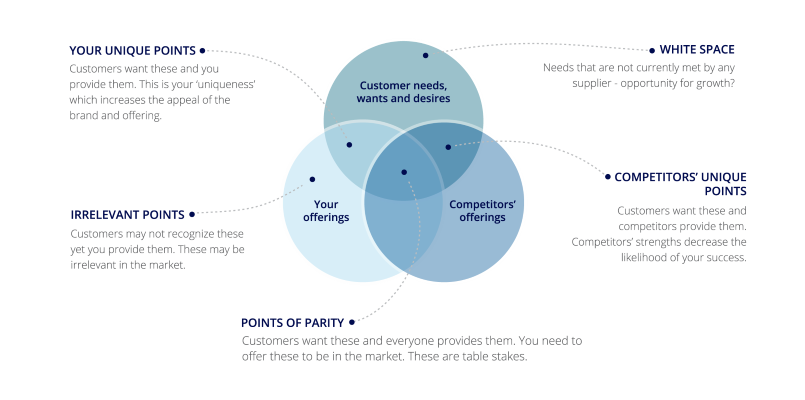
There are also aspects important to customers that only some competitors can deliver, and we might not be able to deliver them at the moment. Additionally, there are aspects we can deliver that customers need, but other companies cannot. These aspects are our true differentiators—market-relevant features that set us apart from competitors. It’s crucial to develop, communicate, and market these differentiators. Delivering a product or solution that already exists in the market and is offered by others doesn’t bring true value to customers. Using this framework helps create winning value propositions by focusing on market relevance and competition, ultimately leading to success.
Niklas: Exactly. It’s a good framework for identifying differentiators, which is crucial in today’s market where there are so many services available. Finding and highlighting the most important differentiators is essential. Every company should consider incorporating this framework into their strategy. You mentioned aspects that need to be delivered by everyone, which brings me to another framework I like to use in customer value proposition projects: the Kano Model.
Understanding Customer Needs with the Kano Model
Niklas: The Kano Model is used in market research to prioritize product features based on customer satisfaction. It helps businesses understand which features will delight customers and which are simply expected. I like this framework because it identifies basic must-have features—essential features every customer expects. These features won’t significantly increase satisfaction, but if they are missing or not functioning properly, customers will be heavily dissatisfied.
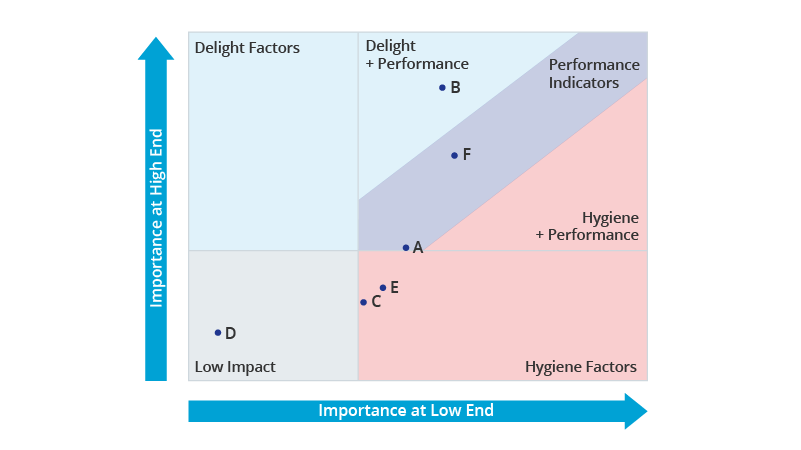
Beata: Like you mentioned with the train, I’m thinking about the internet. It should be a basic expectation that when you work from home, the internet is reliable. It’s not something to boast about if you’re an internet company, but it should be delivered. It doesn’t make me super happy if the internet works, but it makes me very angry when I have problems with it.
Niklas: That’s a very good example. I think everyone has experienced that. Furthermore, we can also see performance features, which have a direct impact on customer satisfaction. The better these features are, the more satisfied the customer will be. For example, the battery life of a smartphone—there’s no doubt that a longer-lasting battery directly connects to satisfaction. Then we have excitement features, also called delighters. These are unexpected things that can greatly increase customer satisfaction when present, but they don’t cause dissatisfaction when missing. They’re like hidden gems that customers don’t expect but appreciate when they find them. For example, when you purchase something and get an extra goodie, like a free accessory or extra points, it raises customer satisfaction significantly.

Beata: I think these delight features can really increase satisfaction disproportionately. Of course, delight features might not be as important during the decision-making process as performance features. For example, when buying machinery, you might compare energy efficiency, price, and material. However, if the company also offers something extra, like additional training for employees or sustainability activities, it can delight customers and make them feel special. I’m glad you mentioned the Kano Model because it’s important to realize what features and aspects of our solution play what roles when creating a value proposition.
It’s not necessary to highlight hygiene features; they just need to be developed to a satisfactory level. For performance features, it’s important to ensure we are better than competitors. We also need to have delight features, which again ties back to differentiators.
Niklas: Exactly. I couldn’t agree more. It’s a great way to see which features of our products are important to customers and what we should market. Sometimes, what we think is different as a company might not be perceived that way by customers. This framework helps us set the right focus and can bring many advantages. I think every company should consider incorporating this business model.
Push-Pull Framework for Introducing New Propositions
Beata: Yeah. And there’s also one more framework that I think is worth discussing: the Push-Pull Framework.
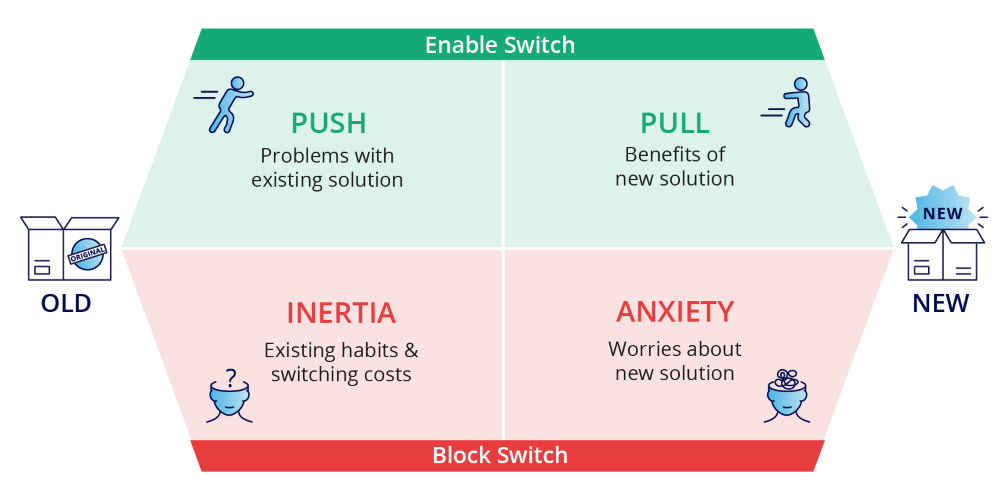
When you introduce or want to introduce a new proposition to the market, it’s important to consider the factors that will help or enable customers to switch from the current solution to the new one. It’s also crucial to understand what can block the switch. You can have a great solution, but if customers can’t switch to it, you won’t be successful.
In this model, we think about aspects that support the switch, such as problems with the existing solutions or dissatisfaction with some features. On the other hand, there are aspects connected with your solution, like the benefits of the new offering. Then, we have the blocks, which can be connected to the current solution. For example, the current solution might be deeply integrated into systems and production processes, making it hard to change.
In banking, many companies are reluctant to switch providers because of the difficulty in informing all partners. Even as customers, we are often unwilling to switch to a new web provider. This applies to all kinds of products and software that are well integrated into systems. There are also blocks connected to your solution, such as concerns about whether your system can be easily integrated and if all features will work smoothly.
It’s good to be aware of these aspects so that when you develop your value proposition, you address all the problems and enhance the pull factors. In your communication, inform clients about the positive aspects of the product and features that make the switch easier.
Niklas: Exactly. It’s very important and a good way to see what you should push and pull, as the name suggests.
Beata: Of course, there are other useful frameworks that can be explored by decision-makers in business. We hope these four examples show how frameworks can support decision-making and market research analysis. If you’re interested in learning more about creating winning value propositions or using frameworks in business and research, we invite you to subscribe to the B2B Insights Podcast. You can also visit our Insights Hub at b2binternational.com/insights.
For now, we’ll finish our discussion. Niklas, thank you very much for accepting the invite and sharing your thoughts on your favorite frameworks. I hope to speak to you soon.
Niklas: Thank you for inviting me. If any of our listeners have a favorite framework, we’d love to hear about it. Let us know what you think is a good framework or what you use daily. Thank you.
Readers of this article also viewed:
What is the Value Proposition Canvas? Using the Push-Pull Model to Successfully Bring New Products to Market How to Apply the Three Circles Framework in Strategic B2B Research Using the Kano Classification Model to Quantify the Importance of Product Features and Attributes B2B Insights Podcast #61: How to Ensure B2B Market Research is Strategic and Actionable B2B Insights Podcast #62: How to Achieve World-Class Quality in B2B Market Research B2B Insights Podcast #63: 2024 Superpowers Index: Deep-Dive Into the Latest Findings PESTLE Analysis: Understanding Market Influences for Better Decision-Making


